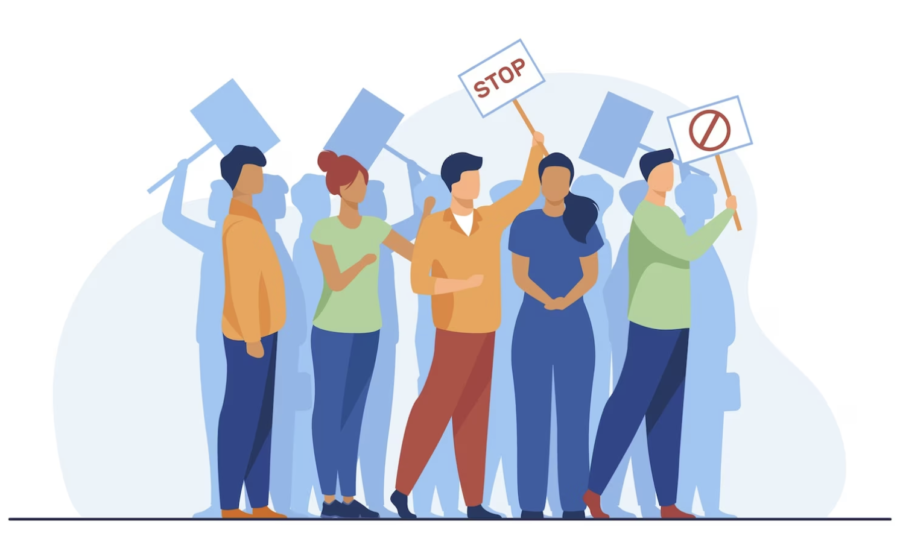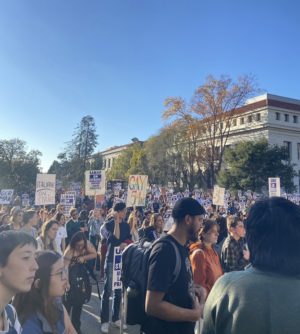A visible shift in the global labor movement is occurring
// Freepik
International Worker’s Day showed a new height of worker protest globally, potentially highlighting a shift in the labor movement.
May 29, 2023
On March 24, more than 1 million people demonstrated across France against pension reform. And over one month later on International Workers’ Day, 800,000 people marched again in France as a way to protect “hard-fought worker rights.” This frustration and collective will to protest hasn’t been just visible in France, however, but in countries across Europe and around the globe as a way to highlight worker rights in this ever-changing global labor culture.
The past few months have been the height of unrest in Europe particularly. Especially in Eurozone countries Britain, France, and Spain, there have been expectations to see an increase in “widespread industrial action” in the coming months. In Britain, high inflation rates have already led to widespread strikes, especially by workers in the railway industry. In France, the pension reform, raising the retirement age from 62 to 64, has led to so much labor unrest to the point where King Charles II postponed his visit to the country because of it. And in Spain, railway, baggage, and airport sector workers have committed to strikes throughout spring. Ultimately, Eurozone countries, ones that tend to be highly unionized and covered with collective bargaining, are continuing to utilize their power through protest.
The unrest isn’t just centered to that region, however, as International Workers’ Day highlighted discontent in places around the world. Thousands of labor unions in Tokyo, for example, criticized government plans to double the defense budget since they viewed it as harmful to social welfare programs. Some successful pro-working class moments occurred worldwide, such as Bolivia’s President Luis Arce leading a Labor Day march with a major union while also announcing a 5% increase in the minimum wage, arguing that the government “is strong because the unions are strong.” But the overall global discontent seems to be higher than in previous years. For example, South Korea’s gatherings to fight for higher wages were its biggest International Workers’ Day gatherings since the beginning of the pandemic.
Additionally, many government interventions have occurred controversially. In Turkey, police stopped demonstrators from reaching Takism Square, a symbolic area in Istanbul for Turkey’s trade unions, while also declaring it off-limits to protest. In France, violence by radicals, using tear gas in a Paris march and having clashes with police, also marked severe anger by some towards the France government. Yet no matter the form of demonstration, the overall message has been clear: millions of workers across the globe are frustrated.
The initial catalyst seems to have been the pandemic and its economic damage; in the US, for example, more frequent and higher magnitude strikes occurred in the first nine months of 2022 than all of 2021. French historian Emmanuel Le Roy Ladurie once called the period plagued by disease from the 14th to 17th century the “unification of the globe by disease,” and it happened again with the COVID-19 pandemic. Workers collectively have protested governments in order to work on the welfare and worker conditions in their areas, many of which are facing increasing energy, food and housing prices.
Johann Somerville, a teacher at DVHS and the secondary chair of negotiations for the San Ramon Valley Education Association, or the SRVEA, describes a broader catalyst for this process, particularly for unions.
“Now you have workers who work from home,” he said. “So now business overheads less and now they’re not paying for you to be in that building and have those lights on and that desk … Now the business is saving money [and you need to] renegotiate that [union] contract — that’s where you see a lot of the [discussion and change].”
He connects this to the changes in the labor industry that have been happening from centuries ago, especially in the U.S.
“Around the world, the worker has been taken advantage of throughout history, and slavery in of itself was free labor,” Somerville explained. “And when that system broke down in this country and when slavery was broken apart in the civil war, businesses had to figure out how they were going to continue to make money the same way. [To do that], they underpaid their wage workers. And the industrial revolution happened and there was no regulation, no oversight and no laws governing work.”
But now, Somerville says that there is a new revolution that we are faced with, the technological revolution. It has led to the conversations we have today in industries across the globe, and combined with the pandemic, it has changed work culture in every country. In terms of remote work for example, a study by Indeed and the OECD finds that the number of global job listings that mention remote work has tripled since the pandemic and the trend of hybrid or remote work is continuing in some developed countries even as the pandemic slows down. Even countries that haven’t integrated remote work into their work culture, such as Japan, are seeing a growth of progressive technology companies promoting that culture, which may change work culture overall.
In some other ways though, the changes in work culture may result in greater unrest, a popular example being the growth of automation and its impact on income inequality globally. For example, Paul Romer, who won a Nobel for his work on technological innovation and economic growth, argues that the unchecked growth of big tech companies can lead to the “collapse of competition,” harming workers and small businesses. Ultimately, the pandemic along with technological growth has allowed the issues some workers face to be highlighted more prominently, and it has increased the call for reform as many industries get hurt by technological growth.
Positive relationships are very much possible between industries and workers; Somerville notes that the SRVEA and the SRVUSD district have a positive relationship with “civility” and a common interest in “building up the relationship so [they] can work together.” But without these relationships, some desired improvements in the status quo are being fought for with difficulty worldwide by workers. With visible protests for higher wages, violence for welfare reform, and frustration with government handling of employment, there’s so much to await and see in how the protests and government responses will evolve. And more importantly, these changes may implicate the work high school students do now or may do in a post-high school world. It may not connect to many students just yet, but once out of the safety net of education, labor culture will hit us. Opinions are shifting, and all we can do is wait and see.





